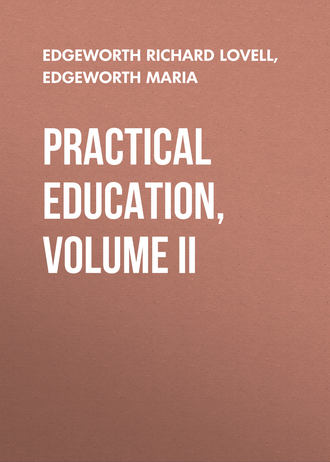 полная версия
полная версияPractical Education, Volume II
Hang a common long scale-beam (without scales or chains) from the top or transom of the frame, so as that one end of it may come within an inch of one side or post of the machine. Tie a rope to the hook of the scale-beam, where the chains of the scale are usually hung, and pass it through the pulley P 3, which is about four feet from the ground; let the person pull this rope from 1 towards 2, turning his back to the machine, and pulling the rope over his shoulder – Pl. 2. Fig. 6. As the pulley may be either too high or too low to permit the rope to be horizontal, the person who pulls it should be placed ten or fifteen feet from the machine, which will lessen the angular direction of the cord, and the inaccuracy of the experiment. Hang weights to the other end of the scale-beam, until the person who pulls can but just walk forward, pulling fairly without propping his feet against any thing. This weight will estimate the force with which he can draw horizontally by a rope over his shoulder.22 Let a child who tries this, walk on the board with dry shoes; let him afterwards chalk his shoes, and afterwards try it with his shoes soaped: he will find that he can pull with different degrees of force in these different circumstances; but when he tries the following experiments, let his shoes be always dry, that his force may be always the same.
To show the power of the three different sorts of leversEXPERIMENT IIInstead of putting the cord that comes from the scale-beam, as in the last experiment, over the shoulder of the boy, hook it to the end 1 of the lever L, Fig. 2. Plate 2. This lever is passed through a socket – Plate 2. Fig. 3. – in which it can be shifted from one of its ends towards the other, and can be fastened at any place by the screw of the socket. This socket has two gudgeons, upon which it, and the lever which it contains, can turn. This socket and its gudgeons can be lifted out of the holes in which it plays, between the rail R R, Plate 2. Fig. 2. and may be put into other holes at R R, Fig. 5. Loop another rope to the other end of this lever, and let the boy pull as before. Perhaps it should be pointed out, that the boy must walk in a direction contrary to that in which he walked before, viz. from 1 towards 3. The height to which the weight ascends, and the distance to which the boy advances, should be carefully marked and measured; and it will be found, that he can raise the weight to the same height, advancing through the same space as in the former experiment. In this case, as both ends of the lever moved through equal spaces, the lever only changed the direction of the motion, and added no mechanical power to the direct strength of the boy.
EXPERIMENT IIIShift the lever to its extremity in the socket; the middle of the lever will be now opposite to the pulley, Pl. 2. Fig. 4. – hook to it the rope that goes through the pulley P 3, and fasten to the other end of the lever the rope by which the boy is to pull. This will be a lever of the second kind, as it is called in books of mechanics; in using which, the resistance is placed between the centre of motion or fulcrum, and the moving power. He will now raise double the weight that he did in Experiment II, and he will advance through double the space.
EXPERIMENT IVShift the lever, and the socket which forms the axis (without shifting the lever from the place in which it was in the socket in the last experiment) to the holes that are prepared for it at R R, Plate 2. Fig. 5. The free end of the lever E will now be opposite to the rope, and to the pulley (over which the rope comes from the scale-beam.) Hook this rope to it, and hook the rope by which the boy pulls, to the middle of the lever. The effect will now be different from what it was in the two last experiments; the boy will advance only half as far, and will raise only half as much weight as before. This is called a lever of the third sort. The first and second kinds of levers are used in quarrying; and the operations of many tools may be referred to them. The third kind of lever is employed but seldom, but its properties may be observed with advantage whilst a long ladder is raised, as the man who raises it, is obliged to exert an increasing force until the ladder is nearly perpendicular. When this lever is used, it is obvious, from what has been said, that the power must always pass through less space than the thing which is to be moved; it can never, therefore, be of service in gaining power. But the object of some machines, is to increase velocity, instead of obtaining power, as in a sledge-hammer moved by mill-work. (V. the plates in Emerson's Mechanics, No. 236.)
The experiments upon levers may be varied at pleasure, increasing or diminishing the mechanical advantage, so as to balance the power and the resistance, to accustom the learners to calculate the relation between the power and the effect in different circumstances; always pointing out, that whatever excess there is in the power,23 or in the resistance, is always compensated by the difference of space through which the inferiour passes.
The experiments which we have mentioned, are sufficiently satisfactory to a pupil, as to the immediate relation between the power and the resistance; but the different spaces through which the power and the resistance move when one exceeds the other, cannot be obvious, without they pass through much larger spaces than levers will permit.
EXPERIMENT VPlace the sledge on the farthest end of the wooden road – Plate 2. Fig. 1. – fasten a rope to the sledge, and conduct it through the lowest pulley P 4, and through the pulley P 3, so as that the boy may be enabled to draw it by the rope passed over his shoulder. The sledge must now be loaded, until the boy can but just advance with short steps steadily upon the wooden road; this must be done with care, as there will be but just room for him beside the rope. He will meet the sledge exactly on the middle of the road, from which he must step aside to pass the sledge. Let the time of this experiment be noted. It is obvious that the boy and the sledge move with equal velocity; there is, therefore, no mechanical advantage obtained by the pulleys. The weight that he can draw will be about half a hundred, if he weigh about nine stone; but the exact force with which the boy draws, is to be known by Experiment I.
The wheel and axleThis organ is usually called in mechanics, The axis in peritrochio. A hard name, which might well be spared, as the word windlass or capstan would convey a more distinct idea to our pupils.
EXPERIMENT VITo the largest drum, Plate 2. Fig. 1. fasten a cord, and pass it through the pulley P downwards, and through the pulley P 4 to the sledge placed at the end of the wooden road, which is farthest from the machine. Let the boy, by a rope fastened to the extremity of one of the arms of the capstan, and passed over his shoulder, draw the capstan round; he will wind the rope round the drum, and draw the sledge upon its road. To make the sledge advance twenty-four feet upon its road, the boy must have walked circularly 144 feet, which is six times as far, and he will be able to draw about three hundred weight, which is six times as much as in the last experiment.
It may now be pointed out, that the difference of space, passed through by the power in this experiment, is exactly equal to the difference of weight, which the boy could draw without the capstan.
EXPERIMENT VIILet the rope be now attached to the smaller drum; the boy will draw nearly twice as much weight upon the sledge as before, and will go through double the space.
EXPERIMENT VIIIWhere there are a number of boys, let five or six of them, whose power of drawing (estimated as in Experiment I) amounts to six times as much as the force of the boy at the capstan, pull at the end of the rope which was fastened to the sledge; they will balance the force of the boy at the capstan: either they, or he, by a sudden pull, may advance, but if they pull fairly, there will be no advantage on either part. In this experiment, the rope should pass through the pulley P 3, and should be coiled round the larger drum. And it must be also observed, that in all experiments upon the motion of bodies, in which there is much friction, as where a sledge is employed, the results are never so uniform as in other circumstances.
The PulleyUpon the pulley we shall say little, as it is in every body's hands, and experiments may be tried upon it without any particular apparatus. It should, however, be distinctly inculcated, that the power is not increased by a fixed pulley. For this purpose, a wheel without a rim, or, to speak with more propriety, a number of spokes fixed in a nave, should be employed. (Plate 2. Fig. 9.) Pieces like the heads of crutches should be fixed at the ends of these spokes, to receive a piece of girth-web, which is used instead of a cord, because a cord would be unsteady; and a strap of iron with a hook to it should play upon the centre, by which it may at times be suspended, and from which at other times a weight may be hung.
EXPERIMENT IXLet the skeleton of a pulley be hung by the iron strap from the transom of the frame; fasten a piece of web to one of the radii, and another to the end of the opposite radius. If two boys of equal weight pull these pieces of girth-web, they will balance each other; or two equal weights hung to these webs, will be in equilibrio. If a piece of girth-web be put round the uppermost radius, two equal weights hung at the ends of it will remain immoveable; but if either of them be pulled, or if a small additional weight be added to either of them, it will descend, and the web will apply itself successively to the ascending radii, and will detach itself from those that are descending. If this movement be carefully considered, it will be perceived, that the web, in unfolding itself, acts in the same manner upon the radii as two ropes would if they were hung to the extremities of the opposite radii in succession. The two radii which are opposite, may be considered as a lever of the first sort, where the centre is in the middle of the lever; as each end moves through an equal space, there is no mechanical advantage. But if this skeleton-pulley be employed as a common block or tackle, its motions and properties will be entirely different.
EXPERIMENT X. PLATE 2. FIG. 9Nail a piece of girth-web to a post, at the distance of three or four feet from the ground; fasten the other end of it to one of the radii. Fasten another piece of web to the opposite radius, and let a boy hold the skeleton-pulley suspended by the web; hook weights to the strap that hangs from the centre. The end of the radius to which the fixed girth-web is fastened, will remain immoveable; but, if the boy pulls the web which he holds in his hand upwards, he will be able to lift nearly double the weight, which he can raise from the ground by a simple rope, without the machine, and he will perceive that his hand moves through twice as great a space as the weight ascends: he has, therefore, the mechanical advantage which he would have by a lever of the second sort, as in Experiment iii. Let a piece of web be put round the under radii, let one end of it be nailed to the post, and the other be held by the boy, and it will represent the application of a rope to a moveable pulley; if its motion be carefully considered, it will appear that the radii, as they successively apply themselves to the web, represent a series of levers of the second kind. A pulley is nothing more than an infinite number of such levers; the cord at one end of the diameter serving as a fulcrum for the organ during its progress. If this skeleton-pulley be used horizontally, instead of perpendicularly, the circumstances which have been mentioned, will appear more obvious.
Upon the wooden road lay down a piece of girth-web; nail one end of it to the road; place the pulley upon the web at the other end of the board, and, bringing the web over the radii, let the boy, taking hold of it, draw the loaded sledge fastened to the hook at the centre of the pulley: he will draw nearly twice as much in this manner as he could without the pulley.24
Here the web lying on the road, shows more distinctly, that it is quiescent where the lowest radius touches it; and if the radii, as they tread upon it, are observed, their points will appear at rest, whilst the centre of the pulley will go as fast as the sledge, and the top of each radius successively (and the boy's hand which unfolds the web) will move twice as fast as the centre of the pulley and the sledge.
If a person, holding a stick in his hand, observes the relative motions of the top, and the middle, and the bottom of the stick, whilst he inclines it, he will see that the bottom of the stick has no motion on the ground, and that the middle has only half the motion of the top. This property of the pulley has been dwelt upon, because it elucidates the motion of a wheel rolling upon the ground; and it explains a common paradox, which appears at first inexplicable. "The bottom of a rolling wheel never moves upon the road." This is asserted only of a wheel moving over hard ground, which, in fact, may be considered rather as laying down its circumference upon the road, than as moving upon it.
The inclined Plane and the WedgeThe inclined plane is to be next considered. When a heavy body is to be raised, it is often convenient to lay a sloping artificial road of planks, up which it may be pushed or drawn. This mechanical power, however, is but of little service without the assistance of wheels or rollers; we shall, therefore, speak of it as it is applied in another manner, under the name of the wedge, which is, in fact, a moving inclined plane; but if it is required to explain the properties of the inclined plane by the panorganon, the wooden road may be raised and set to any inclination that is required, and the sledge may be drawn upon it as in the former experiments.
Let one end of a lever, N. Plate 2. Fig. 7. with a wheel at one end of it, be hinged to the post of the frame, by means of a gudgeon driven or screwed into the post. To prevent this lever from deviating sideways, let a slip of wood be connected with it by a nail, which shall be fast in the lever, but which moves freely in a hole in the rail. The other end of this slip must be fastened to a stake driven into the ground at three or four feet from the lever, at one side of it, and towards the end in which the wheel is fixed (Plate 2. Fig 10. which is a vue d'oiseau) in the same manner as the treadle of a common lathe is managed, and as the treadle of a loom is sometimes guided.25
EXPERIMENT XIUnder the wheel of this lever place an inclined plane or half-wedge (Plate 2. Fig. 7.) on the wooden road, with rollers under it, to prevent friction;26 fasten a rope to the foremost end of the wedge, and pass it through the pulleys (P 4. and P 3.) as in the fifth experiment. Let a boy draw the sledge by this rope over his shoulder, and he will find, that as it advances it will raise the weight upwards; the wedge is five feet long, and elevated one foot. Now, if the perpendicular ascent of the weight, and the space through which he advances, be compared, he will find, that the space through which he has passed will be five times as great as that through which the weight has ascended; and that this wedge has enabled him to raise five times as much as he could raise without it, if his strength were applied, as in Experiment i, without any mechanical advantage. By making this wedge in two parts hinged together, with a graduated piece to keep them asunder, the wedge may be adjusted to any given obliquity; and it will be always found, that the mechanical advantage of the wedge may be ascertained by comparing its perpendicular elevation with its base. If the base of the wedge is 2, 3, 4, 5, or any other number of times greater than its height, it will enable the boy to raise respectively 2, 3, 4, or 5 times more weight than he could do in Experiment i, by which his power is estimated.
The ScrewThe screw is an inclined plane wound round a cylinder; the height of all its revolutions round the cylinder taken together, compared with the space through which the power that turns it passes, is the measure of its mechanical advantage.27 Let the lever, used in the last experiment, be turned in such a manner as to reach from its gudgeon to the shaft of the Panorganon, guided by an attendant lever as before. (Plate 2. Fig. 8.) Let the wheel rest upon the lowest helix or thread of the screw: as the arms of the shaft are turned round, the wheel will ascend, and carry up the weight which is fastened to the lever.28 As the situation of the screw prevents the weight from being suspended exactly from the centre of the screw, proper allowance must be made for this in estimating the force of the screw, or determining the mechanical advantage gained by the lever: this can be done by measuring the perpendicular ascent of the weight, which in all cases is better, and more expeditious, than measuring the parts of a machine, and estimating its force by calculation; because the different diameters of ropes, and other small circumstances, are frequently mistaken in estimates.
The space passed through by the moving power, and by that which it moves, are infallible data for estimating the powers of engines. Two material subjects of experiments, yet remain for the Panorganon; friction, and wheels of carriages: but we have already extended this article far beyond its just proportion to similar chapters in this work. We repeat, that it is not intended in this, or in any other part of our design, to write treatises upon science; but merely to point out methods for initiating young people in the rudiments of knowledge, and of giving them a clear and distinct view of those principles upon which they are founded. No preceptor, who has had experience, will cavil at the superficial knowledge of a boy of twelve or thirteen upon these subjects; he will perceive, that the general view, which we wish to give our pupils of the useful arts and sciences, must certainly tend to form a taste for literature and investigation. The sciolist has learned only to talk– we wish to teach our pupils to think, upon the various objects of human speculation.
The Panorganon may be employed in trying the resistance of air and water; the force of different muscles; and in a great variety of amusing and useful experiments. In academies, and private families, it may be erected in the place allotted for amusement, where it will furnish entertainment for many a vacant hour. When it has lost its novelty, the shaft may from time to time be taken down, and a swing may be suspended in its place. It may be constructed at the expense of five or six pounds: that which stands before our window, was made for less than three guineas, as we had many of the materials beside us for other purposes.
CHAPTER XVIII
CHEMISTRYIn the first attempts to teach chemistry to children, objects should be selected, the principal properties of which may be easily discriminated by the senses of touch, taste or smell; and such terms should be employed as do not require accurate definition.
When a child has been caught in a shower of snow, he goes to the fire to warm and dry himself. After he has been before the fire for some time, instead of becoming dry, he finds that he is wetter than he was before: water drops from his hat and clothes, and the snow with which he was covered disappears. If you ask him what has become of the snow, and why he has become wetter, he cannot tell you. Give him a tea-cup of snow, desire him to place it before the fire, he perceives that the snow melts, that it becomes water. If he puts his finger into the water, he finds that it is warmer than snow; he then perceives that the fire which warmed him, warmed likewise the snow, which then became water; or, in other words, he discovers, that the heat which came from the fire goes into the snow and melts it: he thus acquires the idea of the dissolution of snow by heat.
If the cup containing the water, or melted snow, be taken from the fire, and put out of the window on a frosty day, he perceives, that in time the water grows colder; that a thin, brittle skin spreads over it; which grows thicker by degrees, till at length all the water becomes ice; and if the cup be again put before the fire, the ice returns to water. Thus he discovers, that by diminishing the heat of water, it becomes ice; by adding heat to ice, it becomes water.
A child watches the drops of melted sealing-wax as they fall upon paper. When he sees you stir the wax about, and perceives, that what was formerly hard, now becomes soft and very hot, he will apply his former knowledge of the effects of heat upon ice and snow, and he will tell you that the heat of the candle melts the wax. By these means, the principle of the solution of bodies by heat, will be imprinted upon his memory; and you may now enlarge his ideas of solution.
When a lump of sugar is put into a dish of hot tea, a child sees that it becomes less and less, till at last it disappears. What has become of the sugar? Your pupil will say that it is melted by the heat of the tea: but if it be put into cold tea, or cold water, he will find that it dissolves, though more slowly. You should then show him some fine sand, some clay, and chalk, thrown into water; and he will perceive the difference between mechanical mixture and diffusion, or chemical mixture. Chemical mixture, as that of sugar in water, depends upon the attraction that subsists between the parts of the solid and fluid which are combined. Mechanical mixture is only the suspension of the parts of a solid in a fluid. When fine sand, chalk, or clay, are put into water, the water continues for some time turbid or muddy; but by degrees the sand, &c. falls to the bottom, and the water becomes clear. In the chemical mixture of sugar and water, there is no muddiness, the fluid is clear and transparent, even whilst it is stirred, and when it is at rest, there is no sediment, the sugar is joined with the water; a new, fluid substance, is formed out of the two simple bodies sugar and water, and though the parts which compose the mixture are not discernible to the eye, yet they are perceptible by the taste.
After he has observed the mixture, the child should be asked, whether he knows any method by which he can separate the sugar from the water. In the boiling of a kettle of water, he has seen the steam which issues from the mouth of the vessel; he knows that the steam is formed by the heat from the fire, which joining with the water drives its parts further asunder, and makes it take another form, that of vapour or steam. He may apply this knowledge to the separation of the sugar and water; he may turn the water into steam, and the sugar will be left in the vessel in a solid form. If, instead of evaporating the water, the boy had added a greater quantity of sugar to the mixture, he would have seen, that after a certain time, the water would have dissolved no more of the sugar; the superfluous sugar would fall to the bottom of the vessel as the sand had done: the pupil should then be told that the liquid is saturated with the solid.
By these simple experiments, a child may acquire a general knowledge of solution, evaporation, and saturation, without the formality of a lecture, or the apparatus of a chemist. In all your attempts to instruct him in chemistry, the greatest care should be taken that he should completely understand one experiment, before you proceed to another. The common metaphorical expression, that the mind should have time to digest the food which it receives, is founded upon fact and observation.
Our pupil should see the solution of a variety of substances in fluids, as salt in water; marble, chalk, or alkalies, in acids; and camphire in spirits of wine: this last experiment he may try by himself, as it is not dangerous. Certainly many experiments are dangerous, and therefore unfit for children; but others may be selected, which they may safely try without any assistance; and the dangerous experiments may, when they are necessary, be shown to them by some careful person. Their first experiments should be such as they can readily execute, and of which the result may probably be successful: this success will please and interest the pupils, and will encourage them to perseverance.








